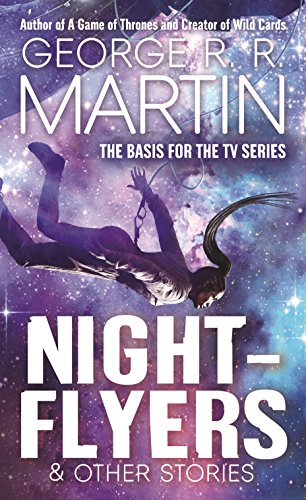George R.R. Martin is famous for two things: First, for starting A Song of Ice and Fire, the fantasy series that became the basis for HBO’s Game of Thrones. Second, for not bothering to finish A Song of Ice and Fire, the fantasy series that has been left in the dust by HBO’s Game of Thrones.
Thanks to Thrones, Martin has become synonymous with drawn-out, hyper-detailed fantasy. But before anyone had heard of Arya or Tyrion, Martin was cranking out stories for the sci-fi pulps of the ’70s like Analog and Fantastic. In many ways, these old-school stories—short and sharp, weird and melancholy—couldn’t be more different from A Song of Ice and Fire. And in many ways, they’re Martin’s best work.
Originally published in 1985, the recently rereleased Nightflyers collects four short stories and two novellas, all of which were were initially published between 1973 and 1980. But the cover text is quick to remind readers that these decades-old stories are still relevant: “Nightflyers,” the first novella in the collection, is set to become a Syfy series later this year.
Buy the Book


Nightflyers & Other Stories
That makes sense: “Nightflyers,” which pits a starship crew against a malevolent force, has already been adapted once, for better or worse (definitely worse), with an all-but-forgotten film from 1987. The best thing about that Nightflyers is Caryn James’ review in the The New York Times, in which she called it “the talkingest movie ever to pose as a science-fiction adventure” before pointing out that “the ship resembles a big blob of chocolate pudding.”
While “Nightflyers” is well-suited for modern TV—with an ensemble cast, grotesque visuals, and a creepy mystery—it’s also the weakest story in this collection. It’s, you know, fine, but its mix of sci-fi and horror feels overly familiar, and its various depravities are inflicted on largely interchangeable characters.
Luckily, the other stories in Nightflyers showcase Martin’s wild, dark imagination—and show us that, when he feels like it, he can pack a maximum impact into a minimum of words.
There’s “Weekend in a War Zone,” a sneering, grimy tale in which everyday businessmen use vacation time to play soldier—with real bullets. There’s “And Seven Times Never Kill Man,” in which religious fanatics from Earth annihilate alien cultures. There’s “Override,” about a miner who digs for valuable swirlstones with the help of reanimated corpses. (“The company discovered that careful hand labor was the only way to keep from chipping or shattering an excessive number of stones,” Martin writes. “And corpse hands were the cheapest hands you could buy.”) And there’s “Nor the Many-Colored Fires of a Star Ring,” where, in an unknowable expanse called Nowhere, humanity discovers the uncaring enormity of the universe. “We’re just for a brief meaningless little time, and nothing makes sense,” says one character. “And the time will come when we’ll be out there, wailing, in a sea of never-ending night.”
Haha! Good times! But the best part of Nightflyers remains 1974’s Hugo-winning novella “A Song for Lya.” Taking place long after humanity has colonized the stars, it’s set on a planet where an ancient but seemingly primitive race, the Shkeen, are devoted to a horrifying, bewildering religion.
At some point in their lives, all Shkeen eagerly submit to “Union”—an act in which they bond with the Greeshka, an organism that, as far as humans can tell, is simply a vicious, mindless parasite. Gleaming like a blob of red jelly, Greeshka pulse on the Shkeen’s heads, slowly engulfing—and consuming—their hosts. When some humans also start to join with the Greeshka, it’s up to two telepaths, Robb and Lyanna, to discover out why anyone, let alone an entire race, would do such a thing.
For all its far-out visuals and evocative lyricism (“The cities of the Shkeen are old, older far than man’s, and the great rust-red metropolis that rose from their sacred hill-country had proved to be the oldest of them all,” the story begins), “A Song for Lya” is ultimately about stuff that’s much more relatable: The thin line between cynicism and hope; the unbridgeable gaps in lived experience; the knowledge, hard-won by anyone who’s ever been in love, that no matter how close we are to a person, we can never truly know them—not as they know themselves. That goes the other way, too: No matter how much we open ourselves to someone, they can never truly know us.
Stories about this kind of painful, fundamental stuff are usually more at home in literary fiction. But in digging into the Shkeen’s horrific symbiosis—in which they happily choose death over life, anonymity over identity—Martin twists apart the ideals most of us hold dear. Part of why “A Song for Lya” works is because Martin gets gleefully weird—examining big, difficult ideas in bizarre, fantastical ways. But even as Martin masterfully envisions a jarringly unfamiliar world, he never forgets that Robb and Lyanna give the novella its emotional punch.
“A Song for Lya” closes out Nightflyers, and it hits hard—44 years after it was written, it’s still heartbreaking and beautiful. It also serves as proof that the George R.R. Martin of the 1970s captured both the alien and the humane as few writers have before or since. That’s something pretty great—and pretty strange—to behold.
Nightflyers & Other Stories is available from Tor Books.
Review originally published in May 2018.
A writer, editor, and male model, Erik Henriksen lives in Portland, Oregon. He’s written for the Portland Mercury, The Stranger, i09.com, Wired.com, and Tor.com. (Hey! That’s this site!) Learn all you ever wanted to know and more at henriksenactual.com.










